สวัสดีครับทุกคน! ผมคือ Michael Zhang นักเดินทางชาวจีนที่มีประสบการณ์ท่องเที่ยวระดับนานาชาติมายาวนาน ผมชอบออกสำรวจจุดหมายที่เต็มไปด้วยประวัติศาสตร์และวัฒนธรรม โดยเฉพาะสถานที่ที่มอบประสบการณ์เชิงลึกให้ผู้มาเยือน วันนี้ผมดีใจมากที่จะได้แนะนำ สวนหลวงเก่าแก่และมีเสน่ห์แห่งกรุงปักกิ่ง — สวนเป๋ยไห่ (Beihai Park) บทความนี้จะเป็นคู่มือท่องเที่ยวที่สมบูรณ์ของสวนเป๋ยไห่ ช่วยให้คุณเข้าใจทั้งประวัติศาสตร์ ไฮไลต์สำคัญ และเคล็ดลับการเดินทางที่เป็นประโยชน์ หวังว่าข้อมูลนี้จะทำให้การเดินทางปักกิ่งของคุณพิเศษยิ่งขึ้น!
สารบัญบทความ
แนะนำสวนเป๋ยไห่ (Beihai Park)
สวนเป๋ยไห่ตั้งอยู่ใจกลางกรุงปักกิ่ง อยู่ทางตะวันตกเฉียงเหนือของพระราชวังต้องห้าม (Forbidden City) เชื่อมต่อกับสวนจิ่งซานทางตะวันออก ด้านใต้ติดกับจงหนานไห่ และทางเหนือใกล้กับเขตสือชาฮ่าย ทั้งหมดมีพื้นที่กว่า 682,000 ตารางเมตร โดยเป็นพื้นที่น้ำ 389,000 ตารางเมตร และพื้นที่บก 293,000 ตารางเมตร จัดว่าเป็นหนึ่งในสวนหลวงแบบคลาสสิกที่เก่าแก่ที่สุดของจีน และยังคงสภาพสมบูรณ์มากที่สุด นอกจากนี้ยังได้รับการจัดอันดับเป็นแหล่งท่องเที่ยวระดับ AAAA ของจีน อีกด้วย
- ที่อยู่: No.1 ถนนเหวินจิน เขตซีเฉิง กรุงปักกิ่ง
- เวลาเปิดทำการ:
- ฤดูท่องเที่ยว (1 เม.ย. – 31 ต.ค.)
- เปิดสวน: 06:00 – 21:00 (หยุดเข้าก่อน 20:30)
- จุดชมวิวภายใน: 08:00 – 18:00 (หยุดเข้าก่อน 17:30)
- นอกฤดูท่องเที่ยว (1 พ.ย. – 31 มี.ค.)
- เปิดสวน: 06:30 – 20:00 (หยุดเข้าก่อน 19:30)
- จุดชมวิวภายใน: 08:30 – 17:00 (หยุดเข้าก่อน 16:30)
- ฤดูท่องเที่ยว (1 เม.ย. – 31 ต.ค.)
- เวลาเที่ยวที่แนะนำ: 2 – 3 ชั่วโมง
- ช่วงเวลาที่ดีที่สุด: ฤดูใบไม้ผลิและฤดูใบไม้ร่วง โดยเฉพาะระหว่างเดือนเมษายนถึงตุลาคม อากาศเย็นสบายและทิวทัศน์งดงาม
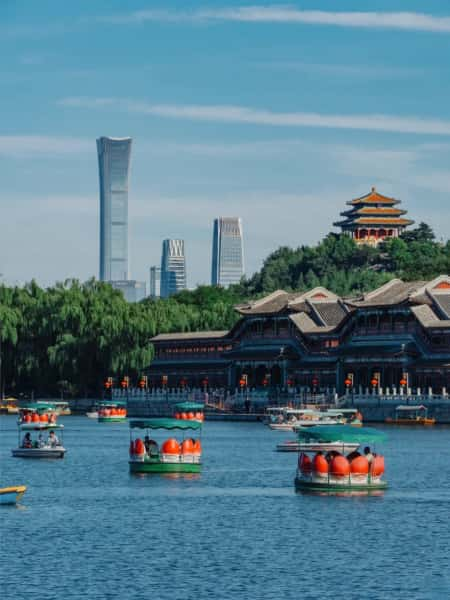
แผนที่สวนเป๋ยไห่ (Beihai Park Map)
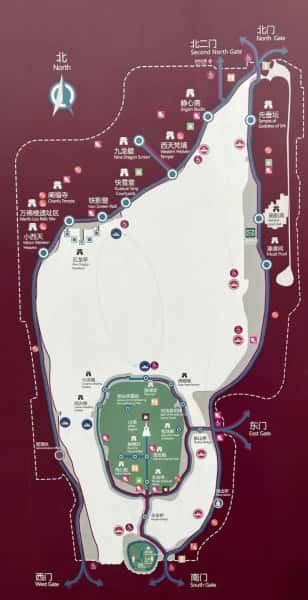
ทำไมคุณถึงควรมาเที่ยวสวนเป๋ยไห่?
ประวัติศาสตร์และคุณค่าทางวัฒนธรรม
สวนเป๋ยไห่ถือเป็นสวนหลวงแห่งแรก ๆ ของจีน ประวัติสามารถย้อนไปได้ถึงราชวงศ์เหลียว และถูกขยายต่อเนื่องผ่านหลายราชวงศ์ ทั้งจิน หยวน หมิง และชิง จนกลายเป็นขนาดปัจจุบัน ในฐานะตัวอย่างของสวนหลวงแบบจีน สวนแห่งนี้ไม่เพียงสะท้อนศิลปะภูมิสถาปัตยกรรมจีน แต่ยังเป็นพยานแห่งพัฒนาการของกรุงปักกิ่งอีกด้วย
ธรรมชาติและจุดเด่นของสถานที่
ภายในสวนแบ่งออกเป็นหลายโซนสำคัญ ได้แก่ เกาะฉงหัว (Qionghua Island) ชายฝั่งตะวันออก ชายฝั่งเหนือ และชายฝั่งตะวันตก มีแลนด์มาร์กมากมาย เช่น สะพานหย่งอัน (Yong’an Bridge) วัดหย่งอัน (Yong’an Temple) เสี่ยวซีเถียน (Xiaoxitian) กำแพงมังกรเก้าตัว (Nine-Dragon Wall) และหอเฉิงกวง (Chengguang Hall) ไฮไลต์สำคัญที่สุดคือ เจดีย์ขาว (White Dagoba) ที่ตั้งอยู่บนเกาะฉงหัว เจดีย์สีขาวล้อมรอบด้วยต้นไม้เขียวและกำแพงสีแดง เกิดเป็นทิวทัศน์ที่งดงามน่าประทับใจ
กิจกรรมและประสบการณ์ที่น่าสนใจ
สวนเป๋ยไห่เหมาะกับกิจกรรมทุกรูปแบบ ไม่ว่าจะเป็นเดินเล่นรอบทะเลสาบ พายเรือ หรือชื่นชมความงามของภูมิทัศน์ ทุกอย่างล้วนทำให้ผู้มาเยือนเพลิดเพลินและอยากกลับมาอีก นอกจากนี้ยังมีจุดท่องเที่ยวที่โดดเด่นอย่าง จิ้งซินไจ๋ (Jingxin Zhai), ฮั่วฟ่างไจ๋ (Huafang Zhai) และ หาวผู่เจี้ยน (Haopu Jian) ซึ่งผสมผสานความยิ่งใหญ่ของสวนหลวงภาคเหนือเข้ากับความประณีตอ่อนช้อยของสวนเจียงหนาน จึงเป็นจุดหมายที่ดีที่สุดในการสัมผัสศิลปะสวนจีนอย่างแท้จริง
กิจกรรมแนะนำในสวนเป๋ยไห่
สถานที่ท่องเที่ยวหลัก
สวนเป๋ยไห่ประกอบด้วย 4 เขตหลัก ได้แก่ เกาะฉงหัว (Qionghua Island), ชายฝั่งตะวันออก, ชายฝั่งเหนือ และเขตถวนเฉิง (Tuancheng) การออกแบบโดยรวมยึดตามตำนาน “บึงหนึ่งภูเขาสาม” โดยมีเกาะฉงหัวเป็นศูนย์กลาง เจดีย์ขาว (White Dagoba) ตั้งตระหง่านบนยอดเขา ด้านใต้มีวัด ส่วนสะพานหย่งอัน (Yong’an Bridge) พาดผ่านถวนเฉิงเชื่อมระหว่างเชิงเขากับยอดเขา สร้างทัศนียภาพที่สมดุลและโดดเด่น
สะพานหย่งอัน (Yong’an Bridge)
สะพานหย่งอันมีประวัติย้อนไปถึงราชวงศ์หยวน เดิมเป็นสะพานไม้ ต่อมาในสมัยหมิงถูกเรียกว่า “สะพานไท่เย่” และในปีค.ศ.1743 (รัชสมัยเฉียนหลง) ได้ถูกบูรณะเป็นสะพานหิน 3 ช่วงโค้ง พร้อมเสาแกะสลัก 48 ต้น สะพานได้รับการซ่อมใหญ่ในปี 1979 โดยเพิ่มเสาแกะสลักดอกบัว 88 ต้น และราวลายใบบัว ทั้งสองด้านยังมีสิงห์หินโบราณและซุ้มประตูหินโบราณประดับไว้ ทำให้สะพานแห่งนี้เป็นสะพานที่ใหญ่ที่สุดในสวนเป๋ยไห่ อีกทั้งยังเป็นจุดชมวิวที่งดงามคู่กับเจดีย์ขาว
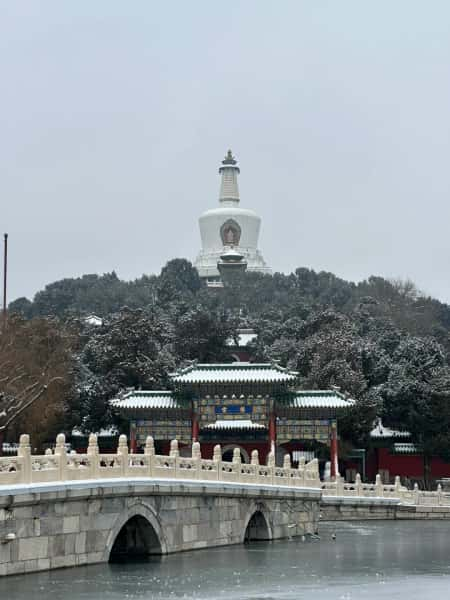
วัดหย่งอัน (Yong’an Temple)
วัดหย่งอันตั้งอยู่เชิงเขาทางใต้ของเจดีย์ขาว ก่อตั้งในปีค.ศ.1651 (สมัยชิง) หรือที่รู้จักกันอีกชื่อว่า “วัดเจดีย์ขาว” วัดแห่งนี้สร้างขึ้นตามคำขอของพระลามะฝ่ายพุทธศาสนาทิเบต ภายในประกอบด้วยวิหารหลักหลายแห่ง เช่น วิหารเจิ้งเจวี๋ย วิหารผู่อัน และวิหารเซิ่งกั๋ว เจดีย์ขาวที่ตั้งอยู่ในบริเวณวัดถือเป็นสัญลักษณ์สำคัญของสวนเป๋ยไห่ รวมทั้งยังสะท้อนทั้งประวัติศาสตร์และศาสนา
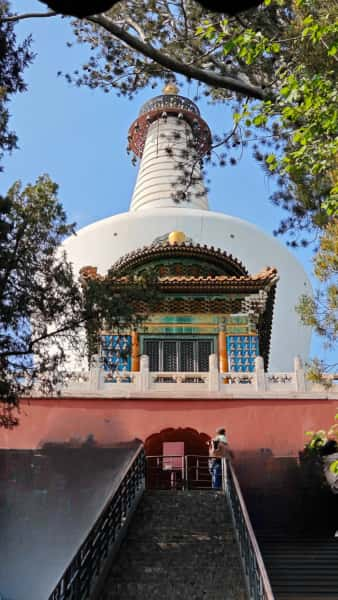
หาวผู่เจี้ยน (Haopu Jian)
หาวผู่เจี้ยนตั้งอยู่ทางฝั่งตะวันออกของสวน ใกล้กับหอฮั่วฟ่างไจ๋และพื้นที่ชุนอวี่หลินถัง อาคารนี้สร้างพร้อมกับสถานที่ใกล้เคียง ใช้หลังคากระเบื้องเทาแบบเรียบง่าย มีพื้นที่กว่า 4,416 ตารางเมตร และอาคารหลักประมาณ 350 ตารางเมตร สถาปัตยกรรมผสมผสานศาลากับระเบียงชมวิวได้อย่างลงตัว จึงเป็นสถานที่เหมาะแก่การสัมผัสความงดงามของธรรมชาติและสถาปัตยกรรมที่กลมกลืนกัน
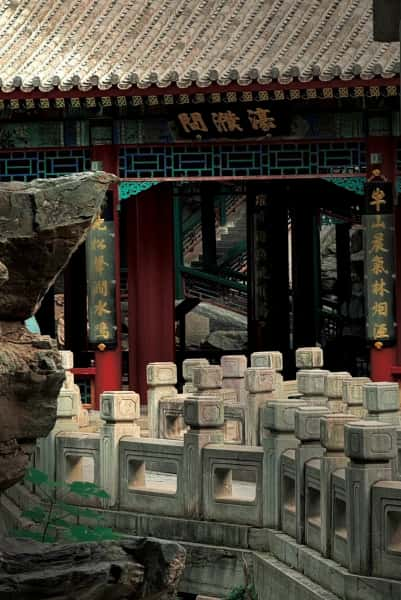
ฮั่วฟ่างไจ๋ (Huafang Zhai)
ฮั่วฟ่างไจ๋สร้างขึ้นในปีค.ศ.1757 ได้แรงบันดาลใจจากบทความของโอวหยางซิ่ว ตั้งอยู่ทางฝั่งตะวันออกของสวน ลักษณะคล้ายเรือใหญ่ที่จอดริมฝั่งน้ำ แต่จริง ๆ แล้วเป็นคฤหาสน์ซ่อนตัวอยู่กลางป่า ภายในแบ่งเป็นวิหารด้านหน้า “ชุนอวี่หลินถัง” และวิหารหลัก “ฮั่วฟ่างไจ๋” พร้อมลานเล็กสองข้าง ได้แก่ “กู่เคอถิง” และ “เสี่ยวหลิงหลง” ทั้งหมดมีการออกแบบอย่างวิจิตร สถานที่นี้เคยเป็นที่พักผ่อนของจักรพรรดิ์เฉียนหลง จักรพรรดิกวงซวี และพระนางซูสีไทเฮา
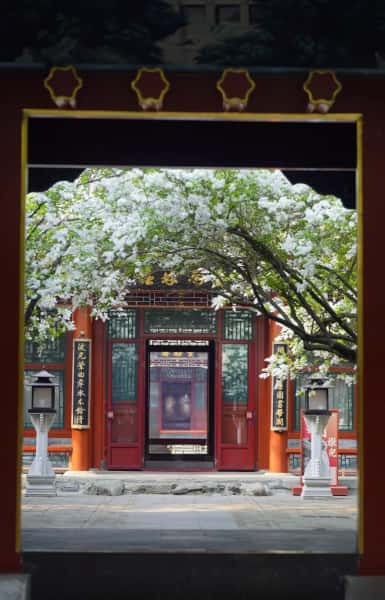
กำแพงเก้ามังกร (Nine-Dragon Wall)
กำแพงเก้ามังกรสร้างขึ้นในปีค.ศ.1756 เดิมตั้งอยู่หน้าวิหารต้าหยวนจิ้งจื้อป่าว ภายหลังกลายเป็นสัญลักษณ์สำคัญของสวน ตัวกำแพงยาว 25.52 เมตร สูง 5.96 เมตร ทั้งสองด้านประดับมังกรเก้าตัวที่กำลังทะยานท่ามกลางคลื่นและเมฆ ใช้กระเบื้องเคลือบเจ็ดสี ทำให้เป็นหนึ่งในกำแพงมังกรเก่าแก่ของจีน และยังเป็นกำแพงมังกรสองหน้าที่หาชมได้ยาก
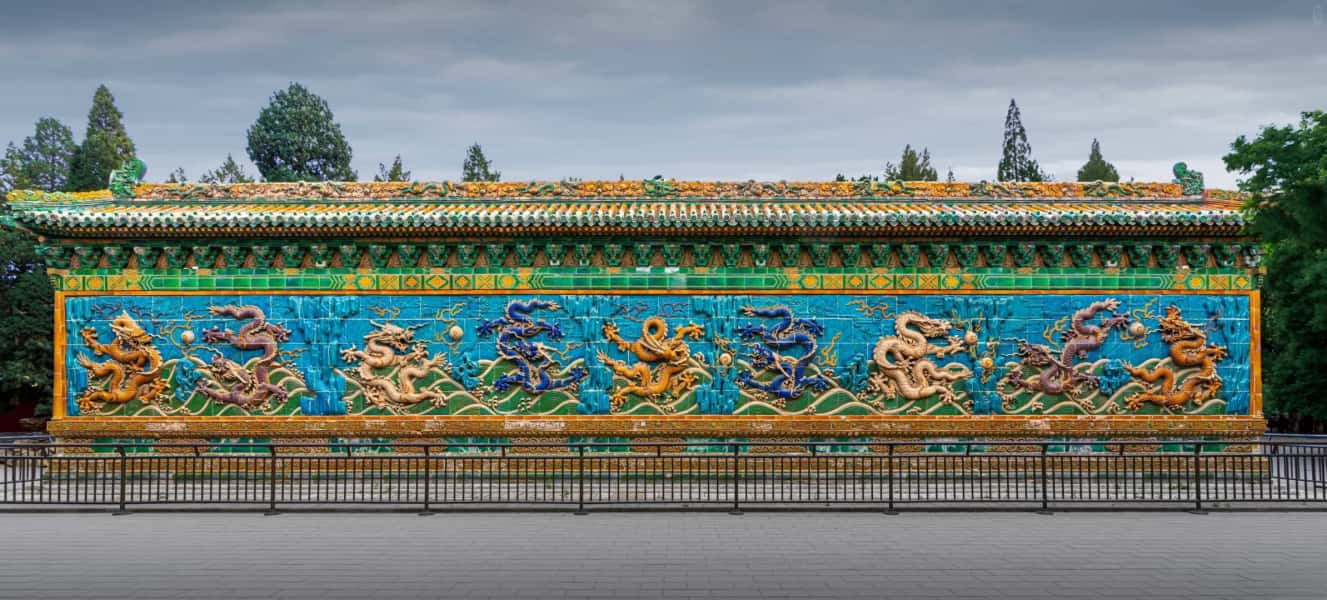
จิ้งซินไจ๋ (Jingxin Zhai)
จิ้งซินไจ๋ หรือชื่อเดิม “จิ้งชิงไจ๋” ตั้งอยู่ทางฝั่งเหนือของสวน ก่อตั้งในปีค.ศ.1756 เดิมทีเป็นบ้านพักของขุนนางสมัยหมิง มีพื้นที่กว่า 8,700 ตารางเมตร ได้รับการยกย่องว่าเป็น “สวนซ้อนสวน” ที่ประณีตที่สุดในสวนเป๋ยไห่ ภายในประกอบด้วยวิหารและศาลาต่าง ๆ เช่น จิ้งชิงไจ๋ เป้าซู่ซูอู่ และปี้เซียนถิง ล้อมรอบด้วยภูเขาและน้ำ ออกแบบให้ผสมผสานความอลังการของสวนภาคเหนือกับความละเมียดละไมของสวนเจียงหนาน
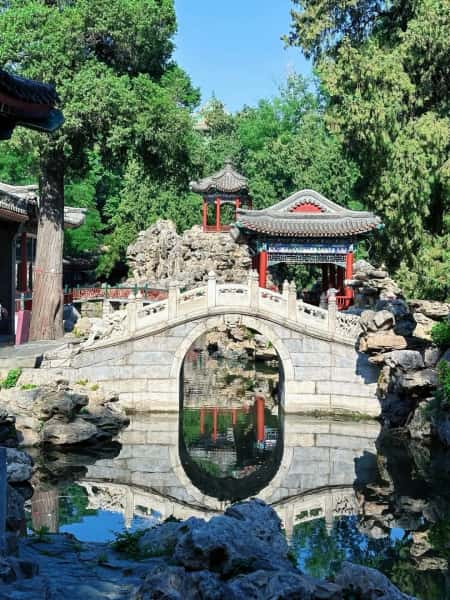
พิพิธภัณฑ์ศิลปะการประดิษฐ์ตัวอักษร ไค๋เสวี่ยถัง (Calligraphy Museum)
ไค๋เสวี่ยถังประกอบด้วยห้องโถงหลัก 3 ส่วน ได้แก่ เฉิงกวนถัง อวี่หลานเซวียน และไค๋เสวี่ยถัง อาคารเหล่านี้สร้างในปีค.ศ.1746 เดิมเป็นพระราชวังย่อยของจักรพรรดิ ต่อมาในปีค.ศ.1779 จักรพรรดิเฉียนหลงได้สร้างไค๋เสวี่ยถังเพิ่มเติมเพื่อเก็บรวบรวมศิลาจารึกอักษร 48 ชิ้น กลายเป็นพิพิธภัณฑ์เฉพาะทางด้านอักษรศาสตร์ที่นักท่องเที่ยวไม่ควรพลาด
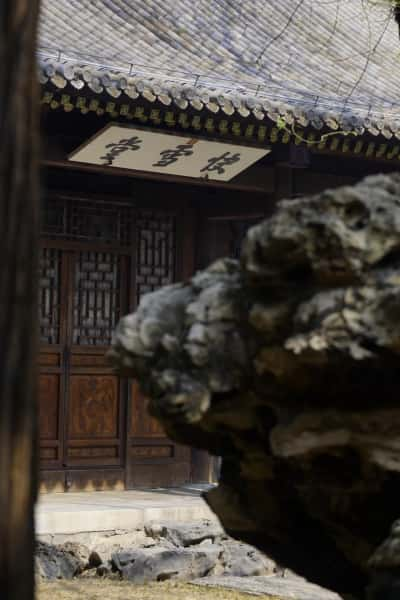
ศาลาห้าพญามังกร (Five-Dragon Pavilions)
ตั้งอยู่มุมตะวันตกเฉียงเหนือของบึงไท่เย่ในสวนเป๋ยไห่ สร้างขึ้นช่วงรัชสมัยหมิงเจียจิ้ง (1522–1566) ประกอบด้วยศาลากลางชื่อหลงเจ๋อ และศาลาด้านซ้าย 2 หลัง ได้แก่ หย่งรุ่ยและฝูฉุ่ย รวมถึงศาลาด้านขวาอีก 2 หลัง คือ เฉิงเซียงและจื๋อเซียง ภายหลังในปีค.ศ.1763 มีการเปลี่ยนสะพานไม้เดิมเป็นสะพานหินพร้อมราวหิน ศาลาห้าพญามังกรในปัจจุบันเป็นจุดชมวิวเจดีย์ขาวและทัศนียภาพทะเลสาบที่ดีที่สุด
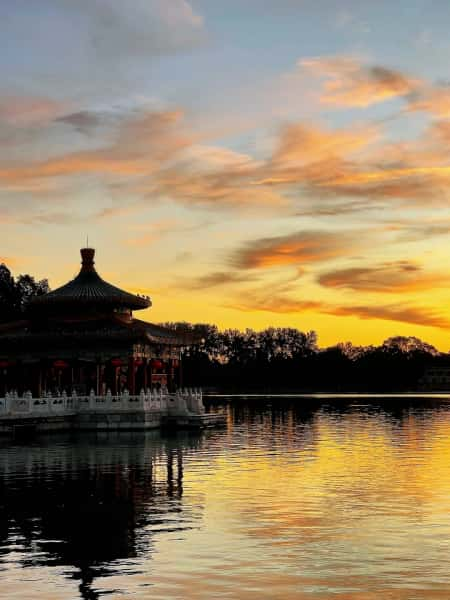
ซีเถียนฝั่นจิ้ง (Xitian Fanjing)
หรือที่เรียกว่า “ต้าซีเถียน” เป็นหนึ่งในโซนที่มีชื่อเสียงที่สุดของสวน ด้านตะวันออกติดกับจิ้งซินไจ๋ ด้านตะวันตกเชื่อมกับวิหารต้าหยวนจิ้งจื้อป่าว และยังต่อเนื่องกับเกาะฉงหัวทางเหนือ–ใต้ ทำให้เกิดแนวทิวทัศน์อันยิ่งใหญ่ เดิมทีเป็นวัดลามะนิกายเซนในสมัยหมิง ต่อมาในปีค.ศ.1759 ได้รับการบูรณะและขยาย และในปี 1980 ได้เปิดใหม่ให้ประชาชนเข้าชม เป็นสถานที่สำคัญในการสัมผัสพุทธศาสนาและความงามของสวน
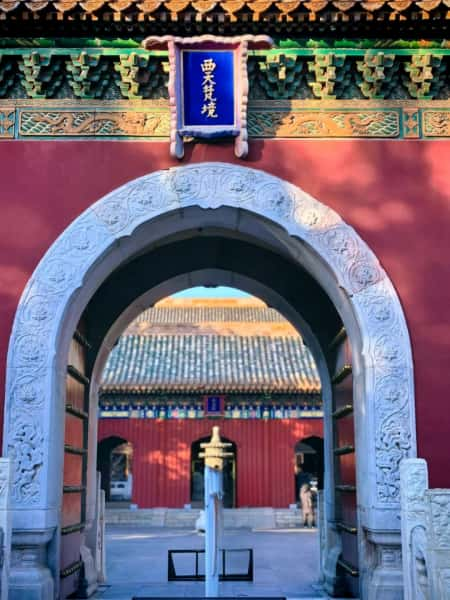
วิหารเฉิงกวง (Chengguang Hall)
ตั้งอยู่ในเขตถวนเฉิง เดิมเคยเป็นส่วนหนึ่งของพระราชวังต้าหนิงในสมัยจิน ต่อมาในสมัยหยวน (ปีค.ศ.1264) ได้สร้างวิหารอี้เถียนขึ้น และในสมัยหมิง (ปีค.ศ.1417) ได้บูรณะและเปลี่ยนชื่อเป็นเฉิงกวงฮอลล์ หลังจากเกิดแผ่นดินไหวในปีค.ศ.1679 วิหารได้รับการบูรณะใหม่ในปีค.ศ.1690 และขยายอีกครั้งในปีค.ศ.1746 ภายในประดิษฐานพระพุทธรูปหยกขาวล้ำค่า ล้อมรอบด้วยต้นสนโบราณและกำแพงทรงกลมของถวนเฉิง
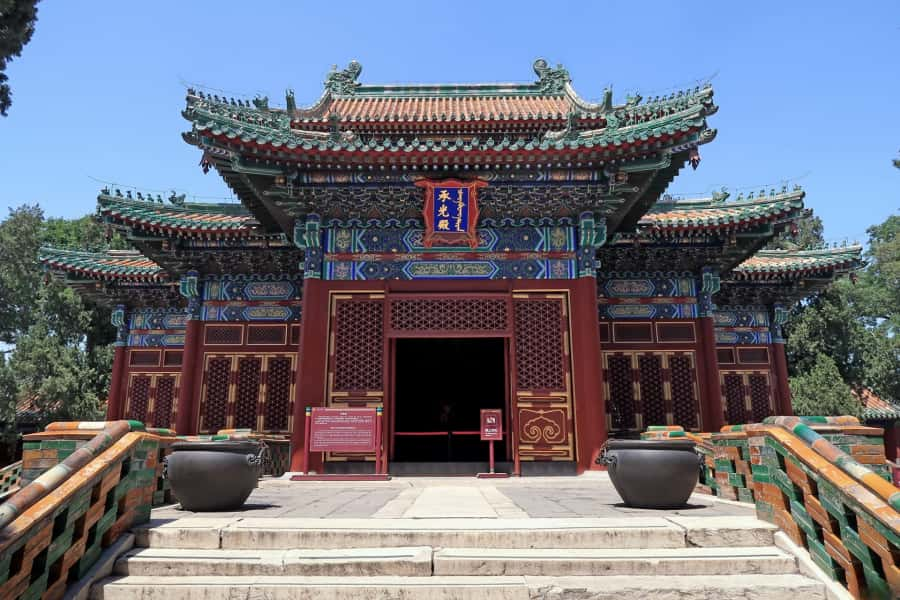
เจดย์หยกใหญ่ (Jade Urn / Dushan Dayuhai)
หรือที่รู้จักในชื่อ “ตู้ซานต้าหยู่ไห่” เป็นวัตถุโบราณล้ำค่าที่จักรพรรดิกุบไลข่านแห่งหยวนสร้างขึ้นในปีค.ศ.1265 ทำจากหินหยกขาวทั้งก้อน มีความสูง 70 ซม. เส้นรอบวง 493 ซม. หนักกว่า 3,500 กก. รอบผิวภาชนะสลักเป็นสัตว์ในตำนาน เช่น มังกรทะเล ม้าน้ำ และแรดทะเล อย่างสมจริง เล่ากันว่ากุบไลข่านเคยใช้ภาชนะนี้ใส่สุราเลี้ยงขุนนาง หลังจากวิหารกวงฮั่นล่มลงในสมัยหมิง ภาชนะชิ้นนี้ได้สูญหายไป ก่อนที่จักรพรรดิเฉียนหลงจะนำกลับมาในปีค.ศ.1745 และสร้างศาลาเฉพาะสำหรับเก็บรักษาในปีค.ศ.1749 ปัจจุบันถือเป็นสมบัติล้ำค่าที่สุดชิ้นหนึ่งของสวนเป๋ยไห่
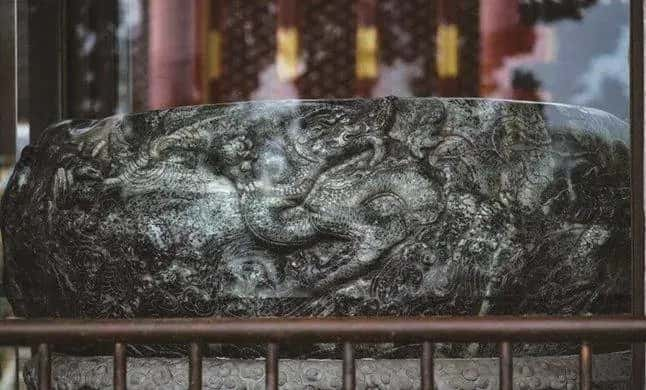
คู่มือซื้อตั๋วเข้าสวนเป๋ยไห่
ราคาบัตรเข้าสวนเป๋ยไห่
- ผู้ใหญ่
- ฤดูท่องเที่ยว (1 เม.ย. – 31 ต.ค.)
- บัตรเข้าสวน: ¥10/ท่าน
- บัตรรวม (แนะนำ): ¥20/ท่าน (รวมค่าบัตรเข้าสวน + สถานที่สำคัญภายใน เช่น วัดหย่งอัน, เขตถวนเฉิง และกำแพงเก้ามังกร)
- นอกฤดูท่องเที่ยว (1 พ.ย. – 31 มี.ค.)
- บัตรเข้าสวน: ¥5/ท่าน
- บัตรรวม (แนะนำ): ¥15/ท่าน
- ฤดูท่องเที่ยว (1 เม.ย. – 31 ต.ค.)
- เด็ก/นักเรียน (เด็กอายุ 6–18 ปี หรือ นักเรียนที่ถือบัตรนักศึกษาระดับต่ำกว่าปริญญาตรี)
- ฤดูท่องเที่ยว
- บัตรเข้าสวน: ¥5/ท่าน
- บัตรรวม (แนะนำ): ¥10/ท่าน
- นอกฤดูท่องเที่ยว
- บัตรเข้าสวน: ¥2.5/ท่าน
- บัตรรวม (แนะนำ): ¥7.5/ท่าน
- ฤดูท่องเที่ยว
- ฟรีค่าเข้าชม
- เด็กสูงไม่เกิน 1.2 เมตร หรืออายุไม่เกิน 6 ปี
- ผู้สูงอายุอายุมากกว่า 60 ปี
เวลาเปิดทำการ
- ฤดูท่องเที่ยว (1 เม.ย. – 31 ต.ค.)
- เปิดสวน: 06:00 – 21:00 (หยุดเข้าก่อน 20:30)
- จุดท่องเที่ยวภายใน (เช่น วัดหย่งอัน, ถวนเฉิง, ฮั่วฟ่างไจ๋): 08:00 – 18:00 (หยุดเข้าก่อน 17:30)
- นอกฤดูท่องเที่ยว (1 พ.ย. – 31 มี.ค.)
- เปิดสวน: 06:30 – 20:00 (หยุดเข้าก่อน 19:30)
- จุดท่องเที่ยวภายใน: 08:30 – 17:00 (หยุดเข้าก่อน 16:30)
วิธีซื้อตั๋ว
- ออนไลน์: ซื้อผ่าน WeChat Official Account ของสวนเป๋ยไห่
- หน้าสวน: ซื้อได้ที่จุดขายตั๋วทุกประตูทางเข้าสวน
คู่มือพายเรือในสวนเป๋ยไห่
ประเภทเรือ
- ตามจำนวนผู้โดยสาร: 4 ที่นั่ง, 6 ที่นั่ง, 8 ที่นั่ง, เรือเฟอร์รี่เล็ก–ใหญ่ และเรือมังกร รวมกว่า 10 แบบ
- ตามวิธีการขับ: เรือไฟฟ้า, เรือถีบ, เรือพายมือ
- ตามดีไซน์: เรือดอกบัว, เรือโบราณ, เรือโยกพาย มีทั้งสไตล์ทันสมัยและแบบคลาสสิกให้เลือก
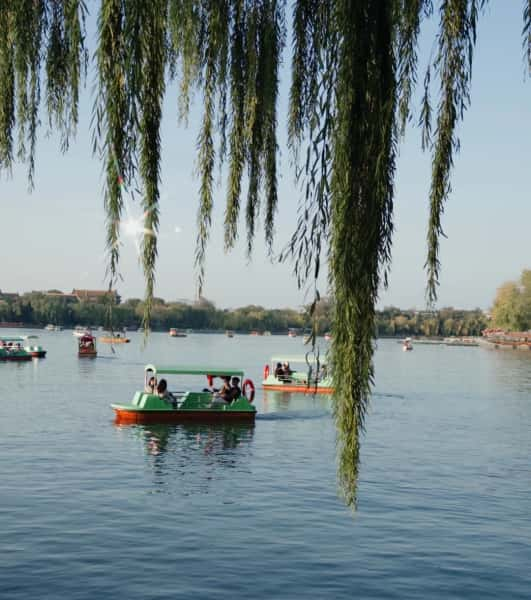
ราคาเช่าเรือ
- เรือไฟฟ้า
- 6 ที่นั่ง: ¥220/ชั่วโมง
- 4 ที่นั่ง: ¥180/ชั่วโมง
- เรือถีบ
- 6 ที่นั่ง: ¥180/ชั่วโมง
- 4 ที่นั่ง: ¥120/ชั่วโมง
- เรือโบราณไฟฟ้า (4 ที่นั่ง): ¥200/ชั่วโมง
ขั้นตอนการเช่า/คืนเรือ
- เช่าเรือ: ชำระเงินมัดจำและรับบัตรเรือที่จุดขายตั๋วริมน้ำ
- ลงเรือ: ใช้บัตรเรือเพื่อลงเรือและเริ่มการเดินทางทางน้ำ
- คืนเรือ: นำเรือกลับท่าที่เช่า แสดงบัตรเรือและใบเสร็จเพื่อรับเงินมัดจำคืนและจ่ายค่าเช่า
ข้อควรระวัง
- เก็บรักษาบัตรเรือและใบเสร็จมัดจำให้ดี เพราะจำเป็นต้องใช้ตอนคืนเรือ
- เรือแต่ละท่ามีประเภทไม่เหมือนกัน และบัตรเรือใช้ได้เฉพาะท่าที่ออกบัตร
คำถามที่พบบ่อย
- ควรเช่าเรือแบบไหนดี?
- เลือกตามจำนวนคนและแรงกาย เรือถีบเหมาะที่สุดเพราะออกกำลังได้เล็กน้อยแต่ไม่เหนื่อยมาก เรือพายมือสนุกที่สุดแต่ใช้แรงมากที่สุด
- ใช้เวลาล่องเรือรอบทะเลสาบนานแค่ไหน?
- เรือไฟฟ้าประมาณ 1 ชั่วโมง เรือถีบใช้เวลา 2–3 ชั่วโมง ขึ้นอยู่กับความเร็ว
- วิวจากเรือพิเศษอย่างไร?
- คุณจะได้เห็นเจดีย์ขาว ศาลา และภูมิทัศน์จากมุมใกล้น้ำ พร้อมทั้งได้ใกล้ชิดกับนกน้ำ เช่น เป็ดหัวเขียว
- ช่วงเวลาเช่าเรือที่คนเยอะที่สุด?
- วันเสาร์–อาทิตย์ โดยเฉพาะท่าเหนือ มักเริ่มมีคิวตั้งแต่ 10:30 น. แนะนำเลือกท่าอื่นเพื่อลดเวลารอ
- เวลาให้บริการเรือ
- เรือเล็ก: ขายบัตรถึง 16:00
- เรือใหญ่: รอบสุดท้ายออกเวลา 16:40
เส้นทางท่องเที่ยวแนะนำในสวนเป๋ยไห่
เส้นทาง 2 ชั่วโมง (ถวนเฉิง + เกาะฉงหัว)
- ถวนเฉิง (ประตูทางเข้า)
- ประตูใต้สวนเป๋ยไห่
- สะพานหย่งอัน
- วัดหย่งอัน
- เจดีย์ขาว
- ลงทางตะวันออกถึงแผ่นหินจงต่าวชุนอิน
- ระเบียงยาว
- หออี้หลาน และเต๋อนิ่งไจ๋
- หอเยว่กู่โหลว
- ข้ามสะพานหย่งอันกลับประตูใต้
จุดเด่น: เน้นเกาะฉงหัวและสถานที่สัญลักษณ์ของสวน เหมาะกับนักท่องเที่ยวที่มีเวลาจำกัด
เส้นทาง 4 ชั่วโมง (เที่ยวครบทั้งสวน)
- ถวนเฉิง (จุดเริ่มต้น)
- เกาะฉงหัว
- หออี้หลาน
- สะพานจื้อซาน
- หาวผู่เจี้ยน
- จิ้งซินไจ๋
- ซีเถียนฝั่นจิ้ง
- กำแพงเก้ามังกร
- ไค๋เสวี่ยถัง
- วัดฉ่านฝู
- ศาลาห้าพญามังกร
จุดเด่น: ครอบคลุมทุกจุดสำคัญของสวน เหมาะกับผู้ที่อยากเที่ยวเชิงลึกและเก็บครบทุกมุม
การเดินทางจากใจกลางปักกิ่งไปสวนเป๋ยไห่
รถไฟใต้ดิน
นั่งสาย 6 ไปลงที่สถานี Beihai North Station ออกทางประตู B หรือ D เดินต่อประมาณ 6 นาทีถึงประตูเหนือของสวนเป๋ยไห่
รถประจำทาง
- ประตูเหนือ: นั่งสาย 13, 42, 107, 111, 118, 612, 701 ลงที่ป้าย Beihai Park North Gate เดินต่อประมาณ 5 นาที
- ประตูตะวันออก: นั่งสาย 5 ลงที่ป้าย Xibanqiao Station เดินต่อประมาณ 4 นาที
- ประตูใต้/ตะวันตกเฉียงใต้: นั่งสาย 5, 101, 103, 109, 124, 128, 专1, 专2 ลงที่ป้าย Beihai Station แล้วเดินถึงทางเข้าสวนได้ทันที
แท็กซี่/รถเรียกผ่านแอป
จากใจกลางเมืองปักกิ่งนั่งแท็กซี่หรือรถเรียกผ่านแอปไปสวนเป๋ยไห่ ใช้เวลา 15–30 นาที ค่าโดยสารประมาณ ¥30–50 ทั้งนี้ขึ้นอยู่กับจุดเริ่มต้นและสภาพการจราจร
ร้านอาหารแนะนำใกล้สวนเป๋ยไห่
หลังเดินเที่ยวสวนเสร็จ คุณสามารถแวะร้านดังรอบ ๆ เพื่อเติมพลัง:
- Chengdu Zhujingban Restaurant (Shudu Hotel)
- จุดเด่น: อาหารเสฉวนแท้ รสจัดจ้าน ปริมาณเยอะ ราคาคุ้มค่า
- ค่าใช้จ่ายเฉลี่ย: ¥104/คน
- เมนูแนะนำ: หมั่วเสวี่ยหวาง, บะหมี่ตันตัน, ฟูฉีเฟยเพี่ยน
- 1901 Cafe (Xisi)
- จุดเด่น: คาเฟ่ดัดแปลงจากโบสถ์ บรรยากาศโรแมนติก เหมาะสำหรับพักผ่อน
- ค่าใช้จ่ายเฉลี่ย: ¥65/คน
- เมนูแนะนำ: อเมริกาโน่, 1901 ซิกเนเจอร์คอฟฟี่, ไอซ์ลาเต้
- Kailaideng Xiangcai (Xisi)
- จุดเด่น: ร้านอาหารหูหนานเก่าแก่ วัตถุดิบสด รสชาติต้นตำรับ บริการดี
- ค่าใช้จ่ายเฉลี่ย: ¥92/คน
- เมนูแนะนำ: ผัดเนื้อเหลือง, เต้าหู้เหม็นฉางชา, ตับหมูสไตล์土匪
- Honghua Dim Sum Bureau (Huguosi)
- จุดเด่น: ของหวานปักกิ่งแบบดั้งเดิม กรอบ หอม หวานกำลังดี
- ค่าใช้จ่ายเฉลี่ย: ¥51/คน
- เมนูแนะนำ: พัฟผีเสื้อ, ขนมสามก๊ก, เต้าฮู้ขาวอัลมอนด์
- Dongfadao Cha Bing Ting (Xidan Joy City)
- จุดเด่น: ร้านอาหารสไตล์ฮ่องกง รสชาติสม่ำเสมอ ไม่มีเมนูพลาด
- ค่าใช้จ่ายเฉลี่ย: ¥85/คน
คำถามที่พบบ่อย
ส่วนใหญ่ของสวนสามารถเข็นรถเด็กได้สะดวก แต่บางจุด เช่น เกาะฉงหัวและจิ้งซินไจ๋ มีบันไดหลายขั้น ทำให้ไม่สะดวก หากต้องการชมในพื้นที่เหล่านี้ แนะนำจอดรถเข็นไว้ที่จุดบริการ หรืออุ้มเด็กแทน
ภายในสวนไม่มีบริการฝากกระเป๋าอย่างเป็นทางการ แต่มีร้านค้ารอบ ๆ ที่รับฝากกระเป๋า ราคาประมาณ ¥10–20 ต่อใบ สะดวกและไม่แพง
รวมลิงก์แนะนำเที่ยวปักกิ่งที่จำเป็น
- คู่มือเที่ยวปักกิ่งฉบับสมบูรณ์ 📖
- แนะนำสถานที่ท่องเที่ยวและแผนเที่ยวปักกิ่ง🏙️
- แนะนำที่พัก 🏨
- คู่มือการเดินทาง ✈️ 🚇 🚄 🚆
- เคล็ดลับและข้อมูลจำเป็นในการท่องเที่ยว 🗺️ 🍜 📱 💸 🌤️ 💊

 English (US)
English (US)  繁體中文
繁體中文 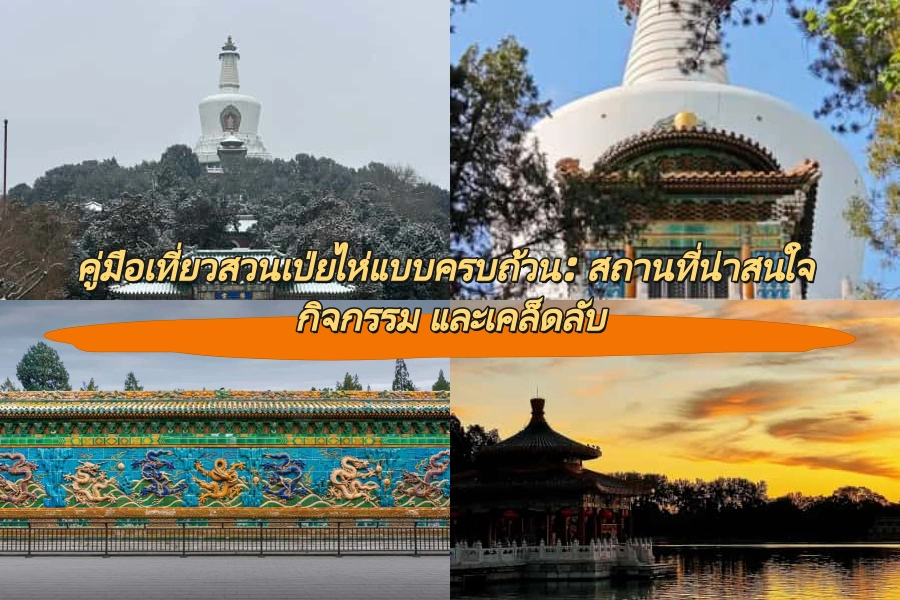
Comment (0)